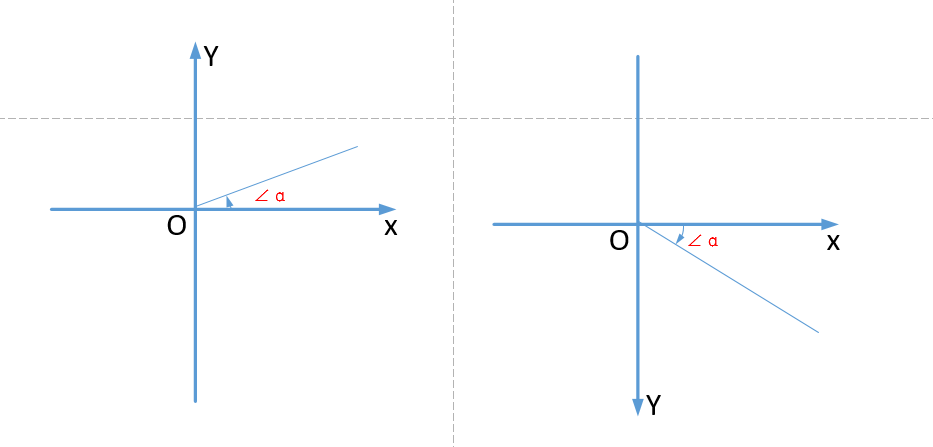概览
自定义View的基本方法
自定义View的最基本的三个方法分别是: onMeasure()、onLayout()、onDraw();
View在Activity中显示出来,要经历测量、布局和绘制三个步骤,分别对应三个动作:measure、layout和draw。
- 测量:onMeasure()决定View的大小;
- 布局:onLayout()决定View在ViewGroup中的位置;
- 绘制:onDraw()决定绘制这个View。
自定义控件分类
- 自定义View: 只需要重写onMeasure()和onDraw()
- 自定义ViewGroup: 则只需要重写onMeasure()和onLayout()
自定义View基础
View的分类
视图View主要分为两类
| 类别 | 解释 | 特点 |
|---|---|---|
| 单一视图 | 即一个View,如TextView | 不包含子View |
| 视图组 | 即多个View组成的ViewGroup,如LinearLayout | 包含子View |
View类简介
- View类是Android中各种组件的基类,如View是ViewGroup基类
- View表现为显示在屏幕上的各种视图
Android中的UI组件都由View、ViewGroup组成。
-
View的构造函数:共有4个
// 如果View是在Java代码里面new的,则调用第一个构造函数 public CarsonView(Context context) { super(context); } // 如果View是在.xml里声明的,则调用第二个构造函数 // 自定义属性是从AttributeSet参数传进来的 public CarsonView(Context context, AttributeSet attrs) { super(context, attrs); } // 不会自动调用 // 一般是在第二个构造函数里主动调用 // 如View有style属性时 public CarsonView(Context context, AttributeSet attrs, int defStyleAttr) { super(context, attrs, defStyleAttr); } //API21之后才使用 // 不会自动调用 // 一般是在第二个构造函数里主动调用 // 如View有style属性时 public CarsonView(Context context, AttributeSet attrs, int defStyleAttr, int defStyleRes) { super(context, attrs, defStyleAttr, defStyleRes); }
AttributeSet与自定义属性
系统自带的View可以在xml中配置属性,对于写的好的自定义View同样可以在xml中配置属性,为了使自定义的View的属性可以在xml中配置,需要以下4个步骤:
- 通过
<declare-styleable>为自定义View添加属性 - 在xml中为相应的属性声明属性值
- 在运行时(一般为构造函数)获取属性值
- 将获取到的属性值应用到View
View视图结构
- PhoneWindow是Android系统中最基本的窗口系统,继承自Windows类,负责管理界面显示以及事件响应。它是Activity与View系统交互的接口
- DecorView是PhoneWindow中的起始节点View,继承于View类,作为整个视图容器来使用。用于设置窗口属性。它本质上是一个FrameLayout
- ViewRoot在Activtiy启动时创建,负责管理、布局、渲染窗口UI等等
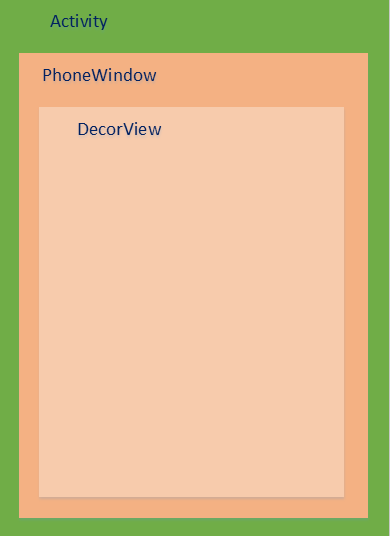
对于多View的视图,结构是树形结构:最顶层是ViewGroup,ViewGroup下可能有多个ViewGroup或View,如下图:
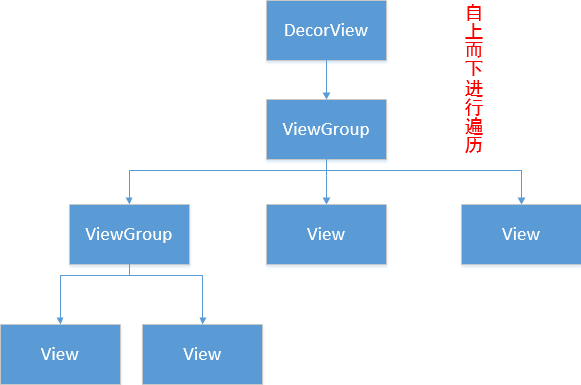
一定要记住:无论是measure过程、layout过程还是draw过程,永远都是从View树的根节点开始测量或计算(即从树的顶端开始),一层一层、一个分支一个分支地进行(即树形递归),最终计算整个View树中各个View,最终确定整个View树的相关属性。
Android坐标系
Android的坐标系定义为:
- 屏幕的左上角为坐标原点
- 向右为x轴增大方向
- 向下为y轴增大方向
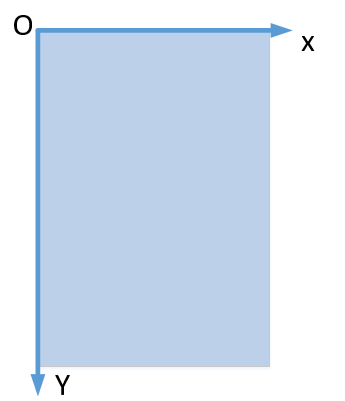
区别于一般的数学坐标系
View位置(坐标)描述
View的位置由4个顶点决定的
4个顶点的位置描述分别由4个值决定:
请记住:View的位置是相对于父控件而言的)
- Top:子View上边界到父view上边界的距离
- Left:子View左边界到父view左边界的距离
- Bottom:子View下边距到父View上边界的距离
- Right:子View右边界到父view左边界的距离
位置获取方式
View的位置是通过view.getxxx()函数进行获取:(以Top为例)
// 获取Top位置
public final int getTop() {
return mTop;
}
// 其余如下:
getLeft(); //获取子View左上角距父View左侧的距离
getBottom(); //获取子View右下角距父View顶部的距离
getRight(); //获取子View右下角距父View左侧的距离
与MotionEvent中 get()和getRaw()的区别
//get() :触摸点相对于其所在组件坐标系的坐标
event.getX();
event.getY();
//getRaw() :触摸点相对于屏幕默认坐标系的坐标
event.getRawX();
event.getRawY();
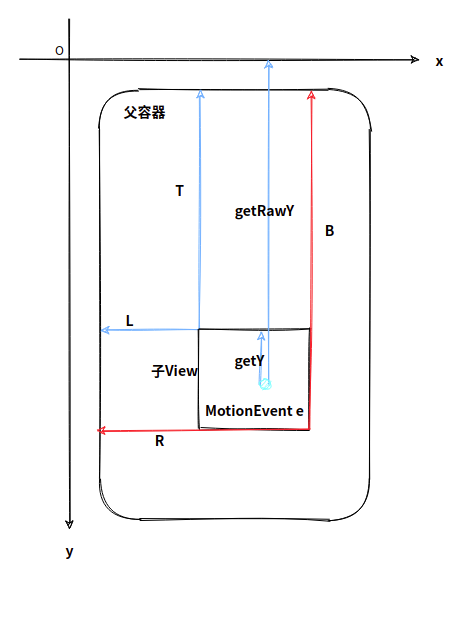
Android中颜色相关内容
Android支持的颜色模式:
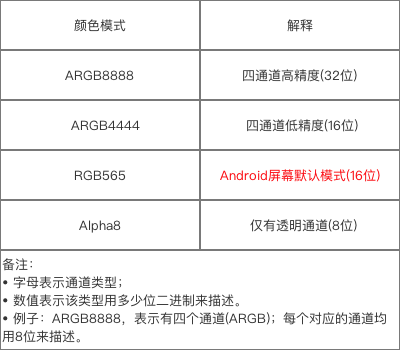
以ARGB8888为例介绍颜色定义:
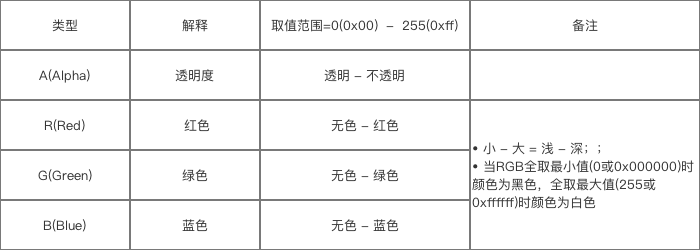
View树的绘制流程
View树的绘制流程是谁负责的?
view树的绘制流程是通过ViewRoot去负责绘制的,ViewRoot这个类的命名有点坑,最初看到这个名字,翻译过来是view的根节点,但是事实完全不是这样,ViewRoot其实不是View的根节点,它连view节点都算不上,它的主要作用是View树的管理者,负责将DecorView和PhoneWindow“组合”起来,而View树的根节点严格意义上来说只有DecorView;每个DecorView都有一个ViewRoot与之关联,这种关联关系是由WindowManager去进行管理的;
view的添加
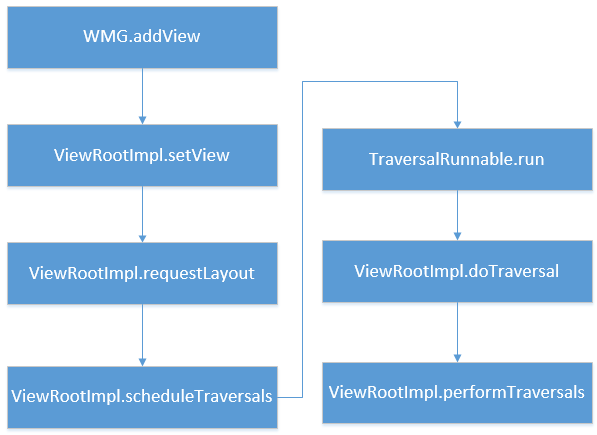
view的绘制流程

measure
- 系统为什么要有measure过程?
- measure过程都干了点什么事?
- 对于自适应的尺寸机制,如何合理的测量一颗View树?
- 那么ViewGroup是如何向子View传递限制信息的?
- ScrollView嵌套ListView问题?
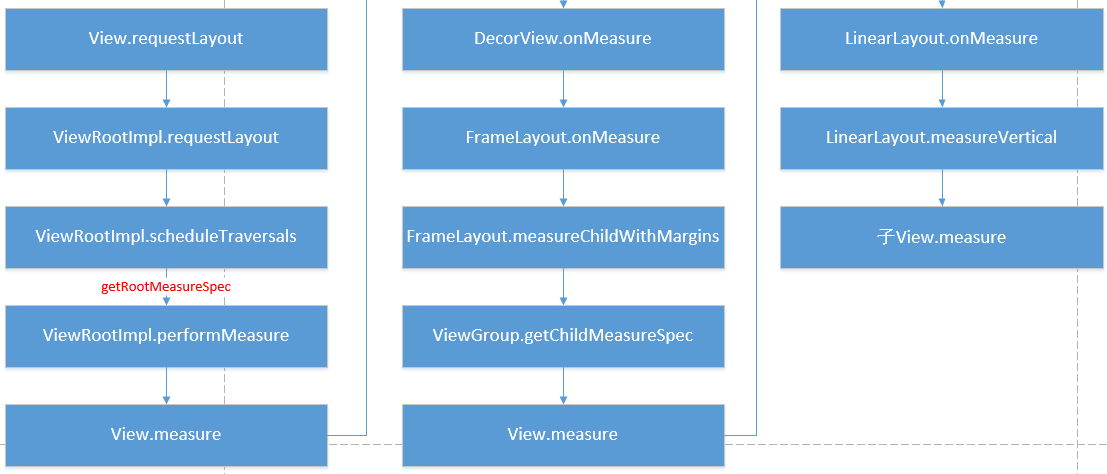
layout
- 系统为什么要有layout过程?
- layout过程都干了点什么事?
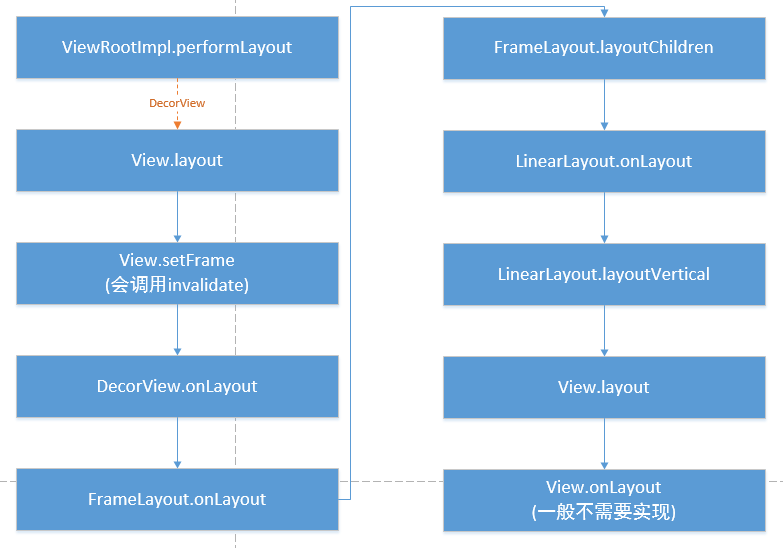
draw
- 系统为什么要有draw过程?
- draw过程都干了点什么事?
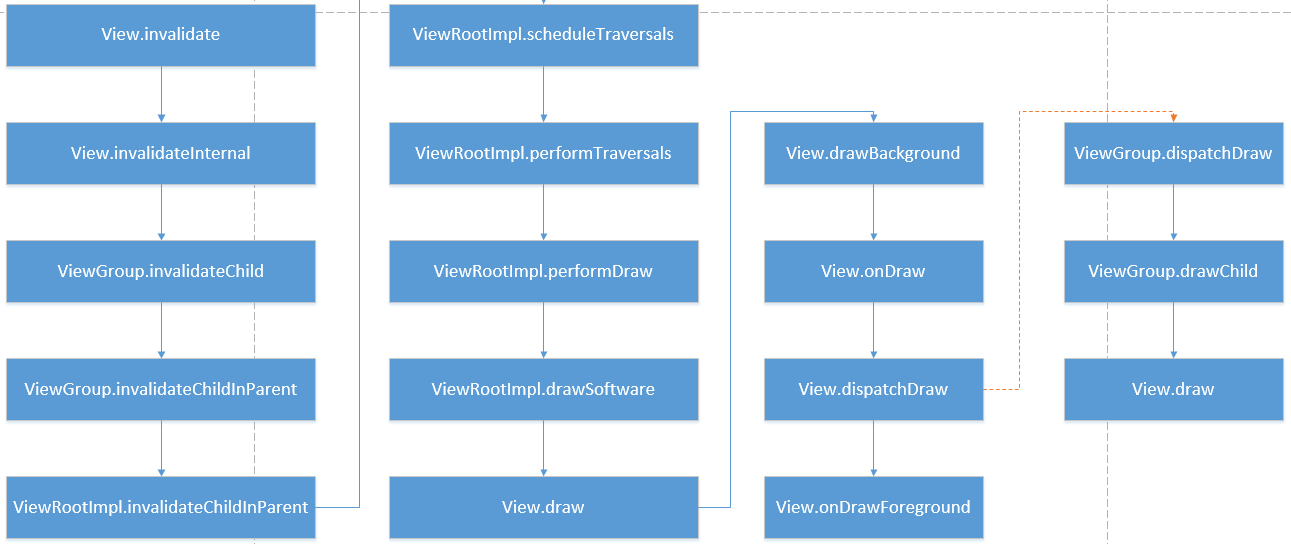
时序图
measure流程
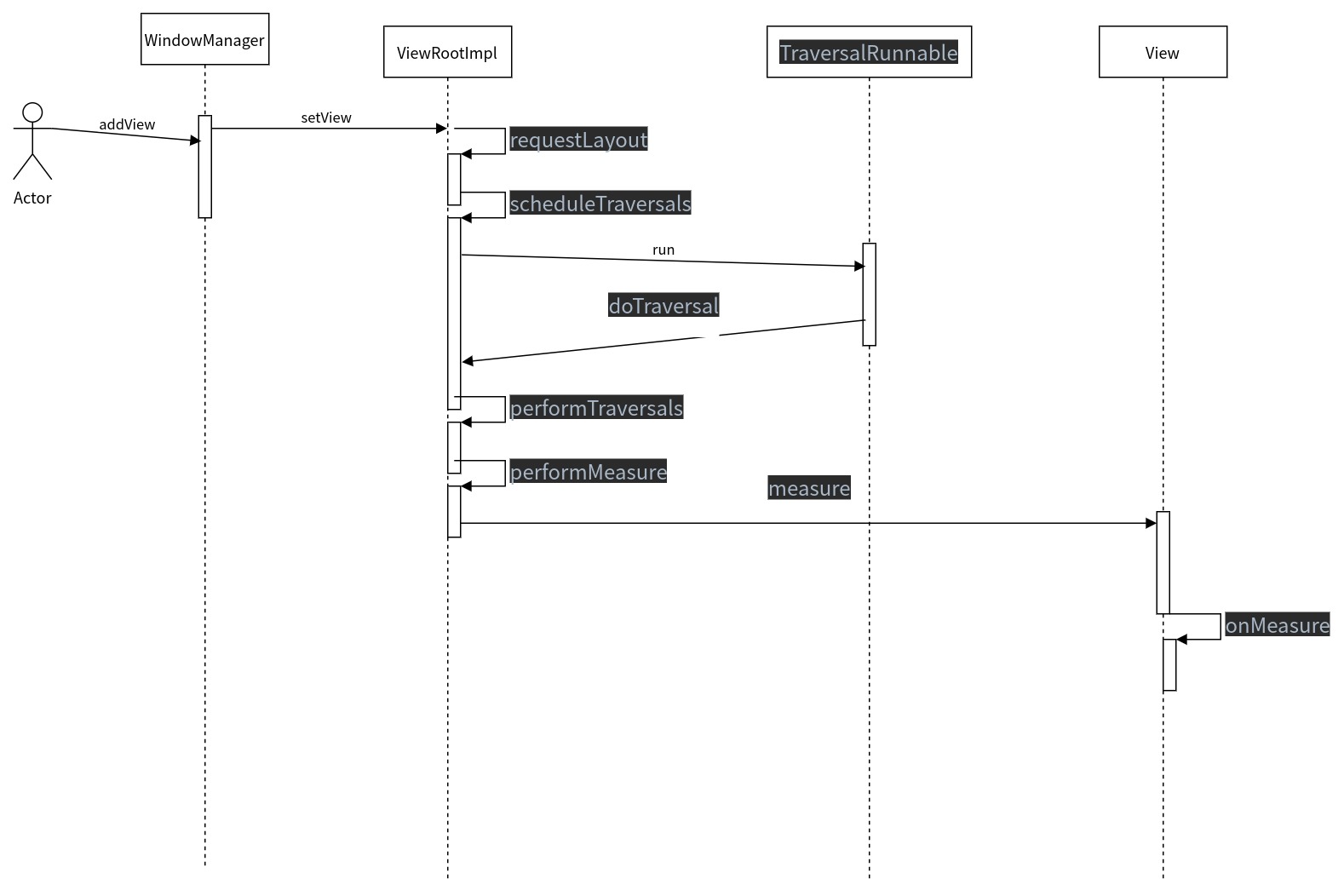
layout流程
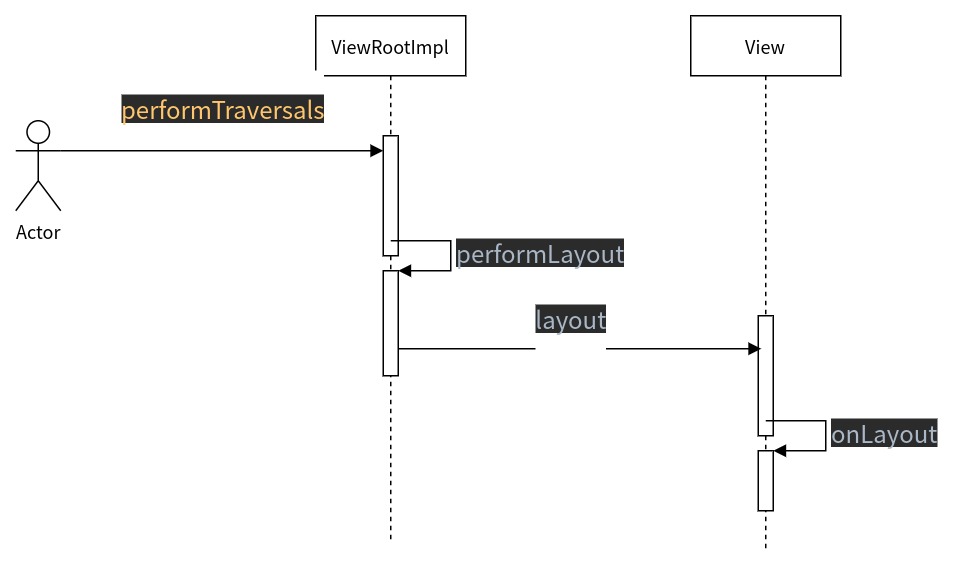
LayoutParams
LayoutParams翻译过来就是布局参数,子View通过LayoutParams告诉父容器(ViewGroup)应该如何放置自己。从这个定义中也可以看出来LayoutParams与ViewGroup是息息相关的,因此脱离ViewGroup谈LayoutParams是没有意义的。
事实上,每个ViewGroup的子类都有自己对应的LayoutParams类,典型的如LinearLayout.LayoutParams和FrameLayout.LayoutParams等,可以看出来LayoutParams都是对应ViewGroup子类的内部类
MarginLayoutParams
MarginLayoutParams是和外间距有关的。事实也确实如此,和LayoutParams相比,MarginLayoutParams只是增加了对上下左右外间距的支持。实际上大部分LayoutParams的实现类都是继承自MarginLayoutParams,因为基本所有的父容器都是支持子View设置外间距的
- 属性优先级问题
MarginLayoutParams主要就是增加了上下左右4种外间距。在构造方法中,先是获取了margin属性;如果该值不合法,就获取horizontalMargin;如果该值不合法,再去获取leftMargin和rightMargin属性(verticalMargin、topMargin和bottomMargin同理)。我们可以据此总结出这几种属性的优先级
margin > horizontalMargin和verticalMargin > leftMargin和RightMargin、topMargin和bottomMargin
- 属性覆盖问题
优先级更高的属性会覆盖掉优先级较低的属性。此外,还要注意一下这几种属性上的注释
Call {@link ViewGroup#setLayoutParams(LayoutParams)} after reassigning a new value
LayoutParams与View如何建立联系
- 在XML中定义View
- 在Java代码中直接生成View对应的实例对象
addView
/**
* 重载方法1:添加一个子View
* 如果这个子View还没有LayoutParams,就为子View设置当前ViewGroup默认的LayoutParams
*/
public void addView(View child) {
addView(child, -1);
}
/**
* 重载方法2:在指定位置添加一个子View
* 如果这个子View还没有LayoutParams,就为子View设置当前ViewGroup默认的LayoutParams
* @param index View将在ViewGroup中被添加的位置(-1代表添加到末尾)
*/
public void addView(View child, int index) {
if (child == null) {
throw new IllegalArgumentException("Cannot add a null child view to a ViewGroup");
}
LayoutParams params = child.getLayoutParams();
if (params == null) {
params = generateDefaultLayoutParams();// 生成当前ViewGroup默认的LayoutParams
if (params == null) {
throw new IllegalArgumentException("generateDefaultLayoutParams() cannot return null");
}
}
addView(child, index, params);
}
/**
* 重载方法3:添加一个子View
* 使用当前ViewGroup默认的LayoutParams,并以传入参数作为LayoutParams的width和height
*/
public void addView(View child, int width, int height) {
final LayoutParams params = generateDefaultLayoutParams(); // 生成当前ViewGroup默认的LayoutParams
params.width = width;
params.height = height;
addView(child, -1, params);
}
/**
* 重载方法4:添加一个子View,并使用传入的LayoutParams
*/
@Override
public void addView(View child, LayoutParams params) {
addView(child, -1, params);
}
/**
* 重载方法4:在指定位置添加一个子View,并使用传入的LayoutParams
*/
public void addView(View child, int index, LayoutParams params) {
if (child == null) {
throw new IllegalArgumentException("Cannot add a null child view to a ViewGroup");
}
// addViewInner() will call child.requestLayout() when setting the new LayoutParams
// therefore, we call requestLayout() on ourselves before, so that the child's request
// will be blocked at our level
requestLayout();
invalidate(true);
addViewInner(child, index, params, false);
}
private void addViewInner(View child, int index, LayoutParams params,
boolean preventRequestLayout) {
.....
if (mTransition != null) {
mTransition.addChild(this, child);
}
if (!checkLayoutParams(params)) { // ① 检查传入的LayoutParams是否合法
params = generateLayoutParams(params); // 如果传入的LayoutParams不合法,将进行转化操作
}
if (preventRequestLayout) { // ② 是否需要阻止重新执行布局流程
child.mLayoutParams = params; // 这不会引起子View重新布局(onMeasure->onLayout->onDraw)
} else {
child.setLayoutParams(params); // 这会引起子View重新布局(onMeasure->onLayout->onDraw)
}
if (index < 0) {
index = mChildrenCount;
}
addInArray(child, index);
// tell our children
if (preventRequestLayout) {
child.assignParent(this);
} else {
child.mParent = this;
}
.....
}
自定义LayoutParams
- 创建自定义属性
<resources>
<declare-styleable name="xxxViewGroup_Layout">
<!-- 自定义的属性 -->
<attr name="layout_simple_attr" format="integer"/>
<!-- 使用系统预置的属性 -->
<attr name="android:layout_gravity"/>
</declare-styleable>
</resources>
- 继承MarginLayout
public static class LayoutParams extends ViewGroup.MarginLayoutParams {
public int simpleAttr;
public int gravity;
public LayoutParams(Context c, AttributeSet attrs) {
super(c, attrs);
// 解析布局属性
TypedArray typedArray = c.obtainStyledAttributes(attrs, R.styleable.SimpleViewGroup_Layout);
simpleAttr = typedArray.getInteger(R.styleable.SimpleViewGroup_Layout_layout_simple_attr, 0);
gravity=typedArray.getInteger(R.styleable.SimpleViewGroup_Layout_android_layout_gravity, -1);
typedArray.recycle();//释放资源
}
public LayoutParams(int width, int height) {
super(width, height);
}
public LayoutParams(MarginLayoutParams source) {
super(source);
}
public LayoutParams(ViewGroup.LayoutParams source) {
super(source);
}
}
- 重写ViewGroup中几个与LayoutParams相关的方法
// 检查LayoutParams是否合法
@Override
protected boolean checkLayoutParams(ViewGroup.LayoutParams p) {
return p instanceof SimpleViewGroup.LayoutParams;
}
// 生成默认的LayoutParams
@Override
protected ViewGroup.LayoutParams generateDefaultLayoutParams() {
return new SimpleViewGroup.LayoutParams(LayoutParams.MATCH_PARENT, LayoutParams.WRAP_CONTENT);
}
// 对传入的LayoutParams进行转化
@Override
protected ViewGroup.LayoutParams generateLayoutParams(ViewGroup.LayoutParams p) {
return new SimpleViewGroup.LayoutParams(p);
}
// 对传入的LayoutParams进行转化
@Override
public ViewGroup.LayoutParams generateLayoutParams(AttributeSet attrs) {
return new SimpleViewGroup.LayoutParams(getContext(), attrs);
}
LayoutParams常见的子类
在为View设置LayoutParams的时候需要根据它的父容器选择对应的LayoutParams,否则结果可能与预期不一致,这里简单罗列一些常见的LayoutParams子类:
- ViewGroup.MarginLayoutParams
- FrameLayout.LayoutParams
- LinearLayout.LayoutParams
- RelativeLayout.LayoutParams
- RecyclerView.LayoutParams
- GridLayoutManager.LayoutParams
- StaggeredGridLayoutManager.LayoutParams
- ViewPager.LayoutParams
- WindowManager.LayoutParams
MeasureSpec
定义

测量规格, 封装了父容器对 view 的布局上的限制 ,内部提供了宽高的信息( SpecMode 、 SpecSize ),SpecSize是指在某种SpecMode下的参考尺寸,其中SpecMode 有如下三种:
- UNSPECIFIED
父控件不对你有任何限制,你想要多大给你多大,想上天就上天。这种情况一般用于系统内部,表示一种测量状态。(这个模式主要用于系统内部多次Measure的情形,例如 recycleerview、scrollview,并不是真的说你想要多大最后就真有多大) - EXACTLY
父控件已经知道你所需的精确大小,你的最终大小应该就是这么大。 - AT_MOST
你的大小不能大于父控件给你指定的size,但具体是多少,得看你自己的实现。

MeasureSpecs 的意义
通过将 SpecMode 和 SpecSize 打包成一个 int 值可以避免过多的对象内存分配,为了方便操作,其提供了打包 / 解包方法
MeasureSpec值的确定
MeasureSpec值到底是如何计算得来的呢?

子View的MeasureSpec值是根据子View的布局参数(LayoutParams)和父容器的MeasureSpec值计算得来的,具体计算逻辑封装在getChildMeasureSpec()里
/**
*
* 目标是将父控件的测量规格和child view的布局参数LayoutParams相结合,得到一个
* 最可能符合条件的child view的测量规格。
* @param spec 父控件的测量规格
* @param padding 父控件里已经占用的大小
* @param childDimension child view布局LayoutParams里的尺寸
* @return child view 的测量规格
*/
public static int getChildMeasureSpec(int spec, int padding, int childDimension) {
int specMode = MeasureSpec.getMode(spec); //父控件的测量模式
int specSize = MeasureSpec.getSize(spec); //父控件的测量大小
int size = Math.max(0, specSize - padding);
int resultSize = 0;
int resultMode = 0;
switch (specMode) {
// 当父控件的测量模式 是 精确模式,也就是有精确的尺寸了
case MeasureSpec.EXACTLY:
//如果child的布局参数有固定值,比如"layout_width" = "100dp"
//那么显然child的测量规格也可以确定下来了,测量大小就是100dp,测量模式也是EXACTLY
if (childDimension >= 0) {
resultSize = childDimension;
resultMode = MeasureSpec.EXACTLY;
}
//如果child的布局参数是"match_parent",也就是想要占满父控件
//而此时父控件是精确模式,也就是能确定自己的尺寸了,那child也能确定自己大小了
else if (childDimension == LayoutParams.MATCH_PARENT) {
resultSize = size;
resultMode = MeasureSpec.EXACTLY;
}
//如果child的布局参数是"wrap_content",也就是想要根据自己的逻辑决定自己大小,
//比如TextView根据设置的字符串大小来决定自己的大小
//那就自己决定呗,不过你的大小肯定不能大于父控件的大小嘛
//所以测量模式就是AT_MOST,测量大小就是父控件的size
else if (childDimension == LayoutParams.WRAP_CONTENT) {
resultSize = size;
resultMode = MeasureSpec.AT_MOST;
}
break;
// 当父控件的测量模式 是 最大模式,也就是说父控件自己还不知道自己的尺寸,但是大小不能超过size
case MeasureSpec.AT_MOST:
//同样的,既然child能确定自己大小,尽管父控件自己还不知道自己大小,也优先满足孩子的需求
if (childDimension >= 0) {
resultSize = childDimension;
resultMode = MeasureSpec.EXACTLY;
}
//child想要和父控件一样大,但父控件自己也不确定自己大小,所以child也无法确定自己大小
//但同样的,child的尺寸上限也是父控件的尺寸上限size
else if (childDimension == LayoutParams.MATCH_PARENT) {
resultSize = size;
resultMode = MeasureSpec.AT_MOST;
}
//child想要根据自己逻辑决定大小,那就自己决定呗
else if (childDimension == LayoutParams.WRAP_CONTENT) {
resultSize = size;
resultMode = MeasureSpec.AT_MOST;
}
break;
// Parent asked to see how big we want to be
case MeasureSpec.UNSPECIFIED:
if (childDimension >= 0) {
// Child wants a specific size... let him have it
resultSize = childDimension;
resultMode = MeasureSpec.EXACTLY;
} else if (childDimension == LayoutParams.MATCH_PARENT) {
// Child wants to be our size... find out how big it should
// be
resultSize = 0;
resultMode = MeasureSpec.UNSPECIFIED;
} else if (childDimension == LayoutParams.WRAP_CONTENT) {
// Child wants to determine its own size.... find out how
// big it should be
resultSize = 0;
resultMode = MeasureSpec.UNSPECIFIED;
}
break;
}
return MeasureSpec.makeMeasureSpec(resultSize, resultMode);
}
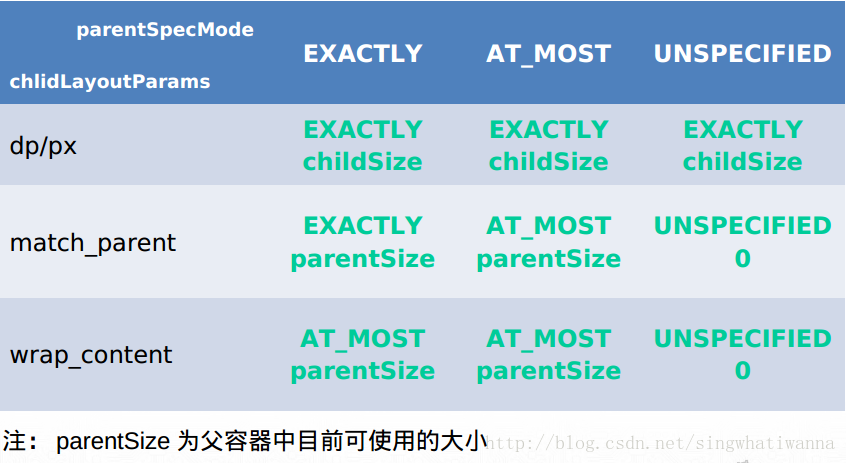
针对上表,这里再做一下具体的说明
-
对于应用层 View ,其 MeasureSpec 由父容器的 MeasureSpec 和自身的 LayoutParams 来共同决定
-
对于不同的父容器和view本身不同的LayoutParams,view就可以有多种MeasureSpec。
-
当view采用固定宽高的时候,不管父容器的MeasureSpec是什么,view的MeasureSpec都是精确模式并且其大小遵循Layoutparams中的大小;
-
当view的宽高是match_parent时,这个时候如果父容器的模式是精准模式,那么view也是精准模式并且其大小是父容器的剩余空间,如果父容器是最大模式,那么view也是最大模式并且其大小不会超过父容器的剩余空间;
-
当view的宽高是wrap_content时,不管父容器的模式是精准还是最大化,view的模式总是最大化并且大小不能超过父容器的剩余空间。
-
Unspecified模式,这个模式主要用于系统内部多次measure的情况下,一般来说,我们不需要关注此模式(这里注意自定义View放到ScrollView的情况 需要处理)。
-

